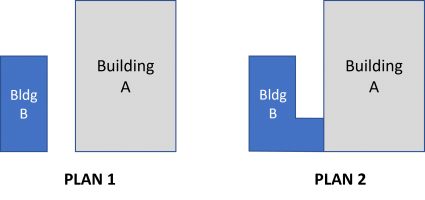Par 705.3 of the 2021 edition of IBC states:
705.3 Buildings on the same lot. For the purposes of determining
the required wall and opening protection, projections
and roof-covering requirements, buildings on the same lot
shall be assumed to have an imaginary line between them.
And then there is exception #1:
Two or more buildings on the same lot shall be
either regulated as separate buildings or shall be
considered as portions of one building if the
aggregate area of such buildings is within the
limits specified in Chapter 5 for a single building.
Where the buildings contain different occupancy
groups or are of different types of construction,
the area shall be that allowed for the most restrictive
occupancy or construction.
I was under the impression that this exception is applicable to maximum areas only, but the current wording makes me wonder.
If I want to build a small business occupancy building (2000 square feet or so) next to an existing larger building on the same lot and at a distance of 3 feet, not exceeding the aggregate area limit for the existing building, can I consider them as portions of the same building instead of separate buildings?
The reason I am asking is that the existing building never had any fire resistance requirement for its non bearing external walls and they are almost 80% tinted glass. Can I use this exception and ignore the separation requirement of Table 705.5 maybe?
705.3 Buildings on the same lot. For the purposes of determining
the required wall and opening protection, projections
and roof-covering requirements, buildings on the same lot
shall be assumed to have an imaginary line between them.
And then there is exception #1:
Two or more buildings on the same lot shall be
either regulated as separate buildings or shall be
considered as portions of one building if the
aggregate area of such buildings is within the
limits specified in Chapter 5 for a single building.
Where the buildings contain different occupancy
groups or are of different types of construction,
the area shall be that allowed for the most restrictive
occupancy or construction.
I was under the impression that this exception is applicable to maximum areas only, but the current wording makes me wonder.
If I want to build a small business occupancy building (2000 square feet or so) next to an existing larger building on the same lot and at a distance of 3 feet, not exceeding the aggregate area limit for the existing building, can I consider them as portions of the same building instead of separate buildings?
The reason I am asking is that the existing building never had any fire resistance requirement for its non bearing external walls and they are almost 80% tinted glass. Can I use this exception and ignore the separation requirement of Table 705.5 maybe?

